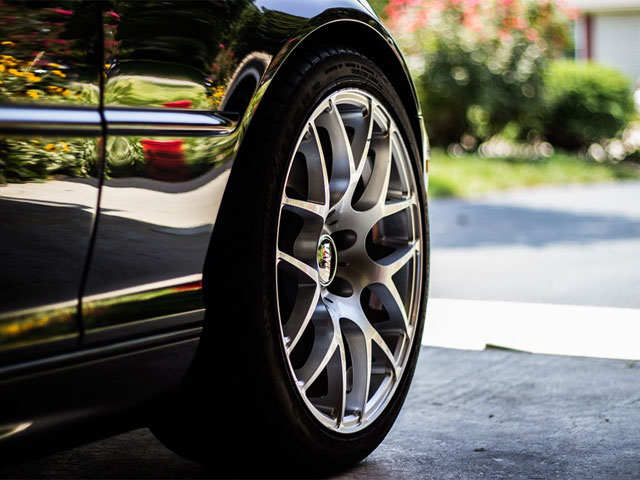How Do I Check My Tire Pressure? From the Continental Tires website.
We recommend taking five minutes at the beginning of each month to check your tire pressure to help save you money and headaches down the road. But how do you check your tire pressure? We can help!
It’s not the tire that supports the weight of your vehicle but rather, the air pressure. So it’s no surprise that tire pressure influences many important characteristics of vehicle performance, such as: driving comfort, directional stability, cornering and braking grip, plus the general handling behavior. Driving with incorrect tire pressure will have a negative influence on one or more of these important characteristics. So it’s important to monitor tire pressure with frequency to ensure optimal performance.
What is my recommended tire pressure?
The tire pressures specified for your vehicle are agreed to between the vehicle manufacturer and the tire producer. The psi is based on your vehicle’s total weight and size, towing weight capability, and recommended tire size. These pressures are set to help keep you safe and comfortable on the road so it’s important to follow them.
But how do you know what the recommended tire pressures are? The recommended tire pressures for your vehicle//tire combination can be found in your vehicle handbook, inside the fuel filler flap or on the driver’s door post.
Why cold inflation pressure?
Recommended tire pressures for your vehicle are based on cold inflation pressure. Gas expands when heated and contracts when temperatures decline. This means that you should check your pressures in the morning before the tire has been run, before the ambient temperature rises, and before exposure to direct sunlight. Hence, cold inflation pressure.
Daily temperatures rise and fall between day and night and as we move through the seasons. Tire pressures can fluctuate 1 psi for every 10 degrees Fahrenheit. So if the outside temperature increases by 10 degrees, the tire pressure will increase by 1 psi. Conversely, if the ambient temperature drops 10 degrees, the tire pressure will decrease by 1 psi.
The pressure inside warm tires will be higher due to the fact that driving causes heat buildup. So you should never reduce the pressure inside warm tires because when they have cooled down, the pressure could fall to below the minimum tire pressure.
As temperatures drop in the fall and winter, it’s especially important to check tire pressures. In the winter, your tires could experience a drop of nearly 5 psi which affects traction, handling and durability. This fluctuation throughout the year leads to the recommendation of checking your tire pressures at the beginning of each month and before long road trips, where the additional load may require the tire pressures to be increased according to the specification. And don’t forget to check your spare tire!
How do I actually check the pressure?
You can check your tire pressure right at home. As mentioned above, just be sure to check pressures when tires are cold, or haven’t been driven in several hours.
You will need an accurate tire pressure gauge which you can find at your local auto parts dealer. There are battery-operated digital gauges and the more traditional stick-type gauge, either one will work and shouldn’t set you back more than $15.
Once you’ve identified the manufacturers recommended pressure, you’re five minutes from completion.
1. Remove the end caps on the valve stems of your tires (don’t lose them!).
2. Place the tire pressure gauge into the valve stem and press down quickly to get a reading.
3. Check the psi reading and compare to the recommended psi.
4. If the reading is above the recommendation, push in the valve to let out some air.
5. If the reading is below the recommendation, fill your tire with air until you’ve reached the recommended pressure.
6. Do this for all the tires on your vehicle…including the spare!
Driving on overinflated tires will have a negative impact on:
• Driving comfort
• Directional stability
• Vehicle handling behavior, especially when cornering at speed
• Irregular wear
Driving on underinflated tires has a negative impact on:
• Steering response
• Directional stability
• Driving safety (tires can dislodge from the rim when cornering)
• Economy (higher fuel consumption, lower mileage)
• Tire durability
• Irregular wear
SAFETY WARNING – Under inflation can lead to the inside of the tire being damaged. This can result in tire failure or even a blowout. Hidden tire damages are not rectified by adjusting the tire pressure.
Can I just rely on the TPMS?
A Tire Pressure Monitoring System (TPMS) must be installed in all new cars. The TPMS can be based on different concepts and sensors. There are essentially two main types of TPMS system:
Direct systems – pressure sensors integrated with the valve or attached to the rim or inside of the tire.
Indirect systems – no pressure sensor fitted to the tire/rim. Pressure differences are measured “indirectly” via for example tire rolling circumference changes.
Car manufacturers may opt either for direct or for indirect systems. While new vehicles are equipped with TPMS, these systems issue a low pressure warning only after tire pressure drops 25 percent below the vehicle manufacturer’s recommended pressure. In many cases a slight drop in air pressure would not trigger a warning light and would cause a loss of fuel economy and could lead to vehicle safety issue. Even with TPMS, motorists need to check tire pressure with a tire gauge every month.
Fitment and maintenance of TPMS systems should be left to the tire specialists.
In summary.
If you’re still uncomfortable checking your own tire pressures, visit Advance Treads your local Continental dealer. They are happy to assist and answer any questions you may have.

